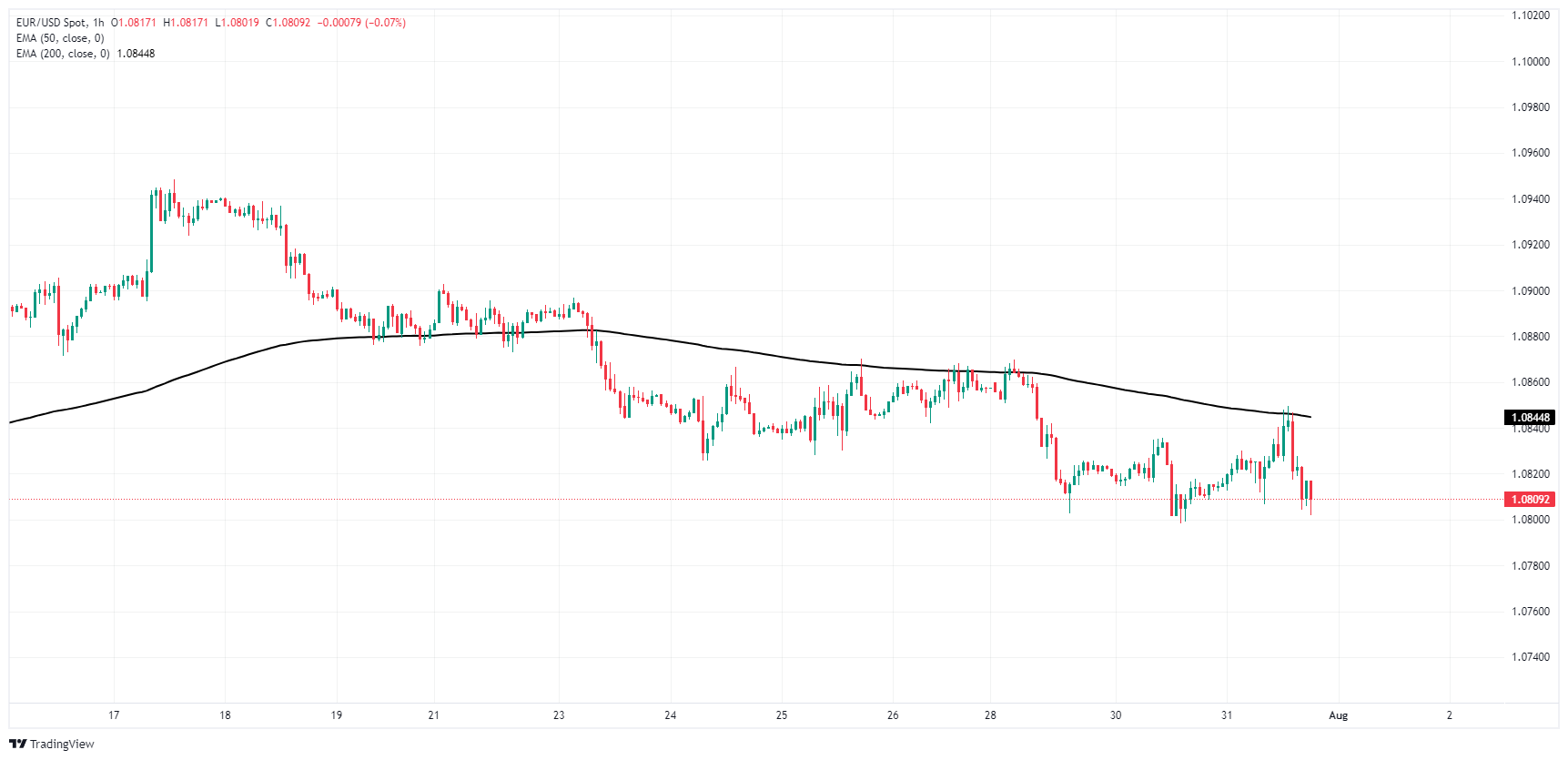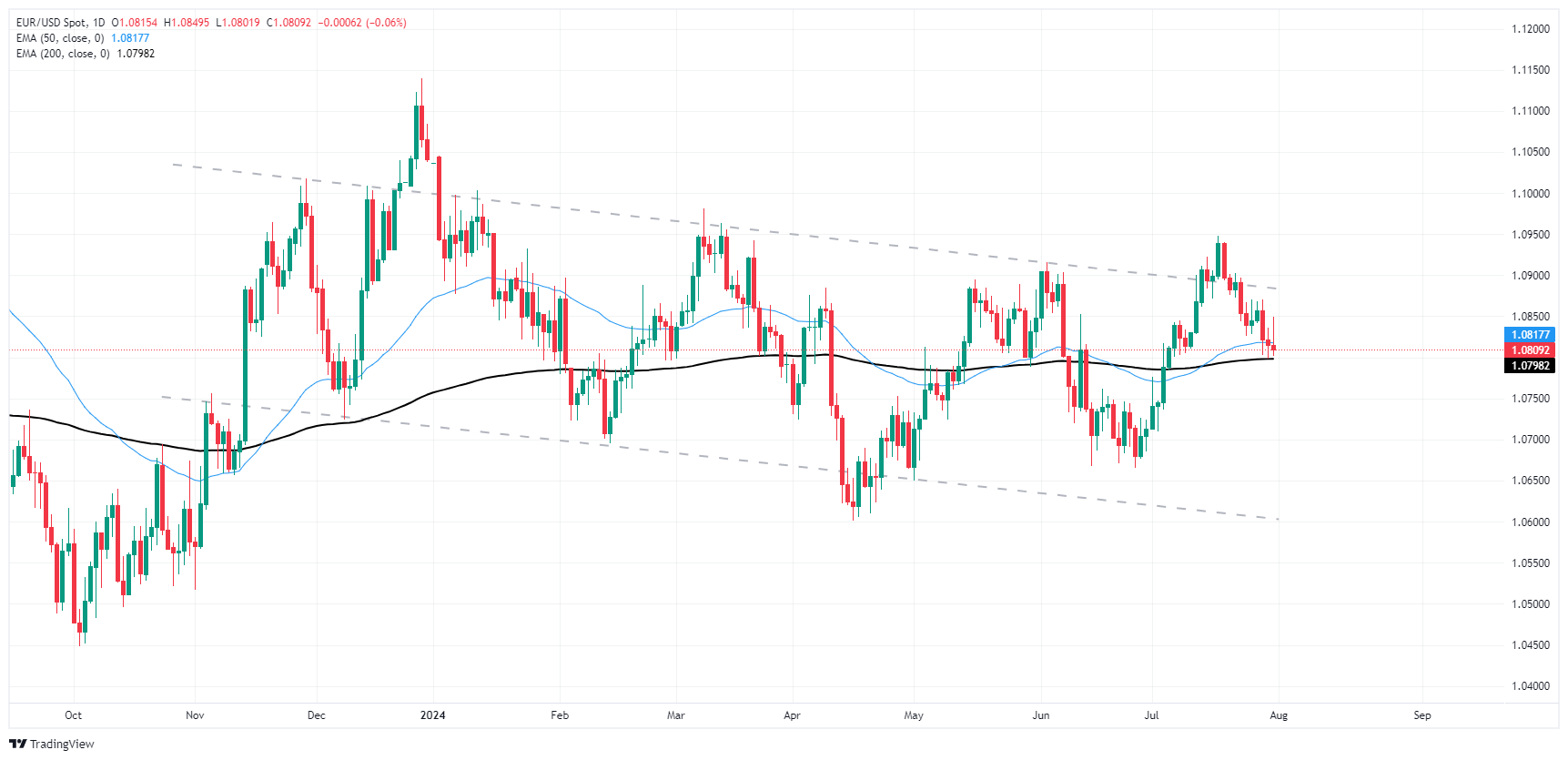- Analiza
- Novosti i instrumenti
- Vesti sa tržišta
- EUR/USD jitters after Fed rate hold, FOMC press conference in view
EUR/USD jitters after Fed rate hold, FOMC press conference in view
- EUR/USD tilted toward the downside after a cautious Fed statement.
- All eyes on Fed Chair Powell’s upcoming press conference.
- Fed language cooled rate cut bets in September, but only slightly.
EUR/USD is churning chart paper near 1.0800 after the Federal Reserve (Fed) struck a notably measured tone regarding interest rates on Wednesday. Shifts in Monetary Policy Report language were much less confident on rate cut expectations than many market participants had been hoping for, with cautious tones about inflation and upbeat employment expectations miring odds of a quarter-point trim in September.
Breaking: Fed leaves interest rate unchanged at 5.25%-5.5% as forecast
Still, markets are pricing in 100% odds of a rate cut when the Federal Open Market Committee (FOMC) convenes in September, but added emphasis on key US data in the weeks ahead will spark more volatility as investors hope, counterintuitively, for a continued softening in headline US economic data to keep the Fed on the rails to a rate cut on September 18.
US Nonfarm Payrolls (NFP) clouds the scope for Friday, with forecasts calling for another downturn in overall US hiring while Average Hourly Earnings are expected to hold steady month-on-month.
EUR/USD technical outlook
Fiber remains mired in intraday technical congestion near the 1.0800 handle as bulls fail repeatedly to push near-term bidding back above the 200-hour Exponential Moving Average (EMA) near 1.0844. Price action is grinding into the midrange as daily candlesticks find technical support from the 200-day EMA at 1.0798, but momentum remains bearish as EUR/USD grinds down from the last swing high just above 1.0940.
EUR/USD hourly chart
EUR/USD daily chart
Fed FAQs
Monetary policy in the US is shaped by the Federal Reserve (Fed). The Fed has two mandates: to achieve price stability and foster full employment. Its primary tool to achieve these goals is by adjusting interest rates. When prices are rising too quickly and inflation is above the Fed’s 2% target, it raises interest rates, increasing borrowing costs throughout the economy. This results in a stronger US Dollar (USD) as it makes the US a more attractive place for international investors to park their money. When inflation falls below 2% or the Unemployment Rate is too high, the Fed may lower interest rates to encourage borrowing, which weighs on the Greenback.
The Federal Reserve (Fed) holds eight policy meetings a year, where the Federal Open Market Committee (FOMC) assesses economic conditions and makes monetary policy decisions. The FOMC is attended by twelve Fed officials – the seven members of the Board of Governors, the president of the Federal Reserve Bank of New York, and four of the remaining eleven regional Reserve Bank presidents, who serve one-year terms on a rotating basis.
In extreme situations, the Federal Reserve may resort to a policy named Quantitative Easing (QE). QE is the process by which the Fed substantially increases the flow of credit in a stuck financial system. It is a non-standard policy measure used during crises or when inflation is extremely low. It was the Fed’s weapon of choice during the Great Financial Crisis in 2008. It involves the Fed printing more Dollars and using them to buy high grade bonds from financial institutions. QE usually weakens the US Dollar.
Quantitative tightening (QT) is the reverse process of QE, whereby the Federal Reserve stops buying bonds from financial institutions and does not reinvest the principal from the bonds it holds maturing, to purchase new bonds. It is usually positive for the value of the US Dollar.
© 2000-2024. Sva prava zaštićena.
Sajt je vlasništvo kompanije Teletrade D.J. LLC 2351 LLC 2022 (Euro House, Richmond Hill Road, Kingstown, VC0100, St. Vincent and the Grenadines).
Svi podaci koji se nalaze na sajtu ne predstavljaju osnovu za donošenje investicionih odluka, već su informativnog karaktera.
The company does not serve or provide services to customers who are residents of the US, Canada, Iran, The Democratic People's Republic of Korea, Yemen and FATF blacklisted countries.
Izvršenje trgovinskih operacija sa finansijskim instrumentima upotrebom marginalne trgovine pruža velike mogućnosti i omogućava investitorima ostvarivanje visokih prihoda. Međutim, takav vid trgovine povezan je sa potencijalno visokim nivoom rizika od gubitka sredstava. Проведение торговых операций на финанcовых рынках c маржинальными финанcовыми инcтрументами открывает широкие возможноcти, и позволяет инвеcторам, готовым пойти на риcк, получать выcокую прибыль, но при этом неcет в cебе потенциально выcокий уровень риcка получения убытков. Iz tog razloga je pre započinjanja trgovine potrebno odlučiti o izboru odgovarajuće investicione strategije, uzimajući u obzir raspoložive resurse.
Upotreba informacija: U slučaju potpunog ili delimičnog preuzimanja i daljeg korišćenja materijala koji se nalazi na sajtu, potrebno je navesti link odgovarajuće stranice na sajtu kompanije TeleTrade-a kao izvora informacija. Upotreba materijala na internetu mora biti praćena hiper linkom do web stranice teletrade.org. Automatski uvoz materijala i informacija sa stranice je zabranjen.
Ako imate bilo kakvih pitanja, obratite nam se pr@teletrade.global.















